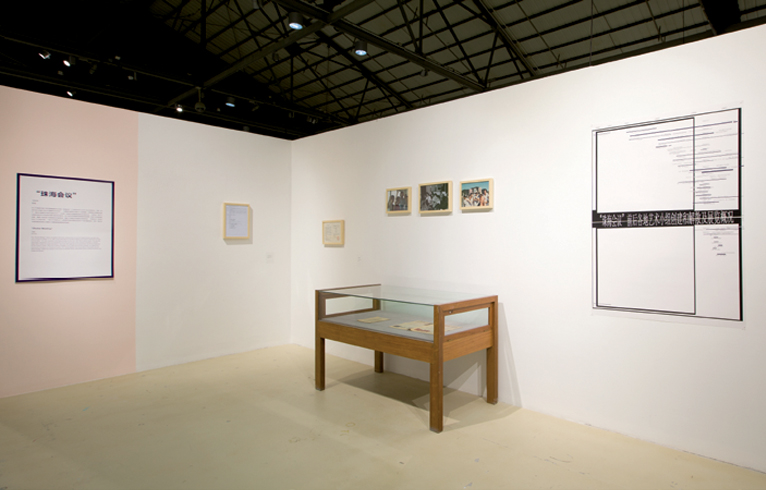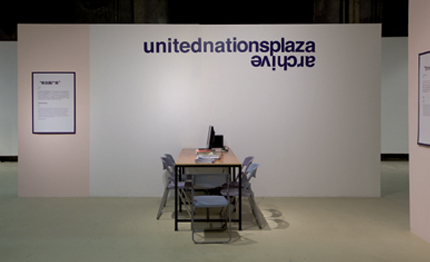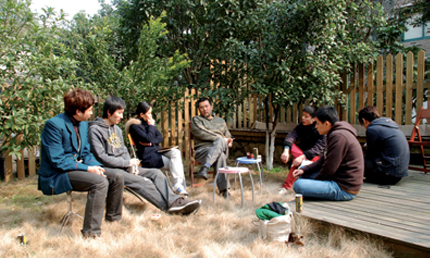WHAT IS “LITTLE MOVEMENTS” EXHIBITING?
| November 29, 2011 | Post In LEAP 11

WE WRITE THIS article but three days before the opening of “Little Movements: Self-practice in Contemporary Art” at OCT Contemporary Art Terminal. Our expectations are high. With OCAT’s support, we began our research for “Little Movements” nearly a year ago. This past year, in artist studios, art spaces, and other places of artistic practice, we organized more than a dozen group discussions. These conversations formed the very methods of practice identified and included in our research plans, and helped us to continually identify and understand the problems involved in that research. In the process of launching this self-learning approach, we also launched a project for thought generation together with the practitioners with whom we were in dialogue.
Our three-person curatorial team includes an artist, a curator and a critic. This working method was formed over the course of our long-term collaboration, and is also a product of the importance we have always placed on artistic practice. In our view, in the art system, every actor of every role is a practitioner; our evaluation of his/her importance ultimately relies on the quality of his/her practice, rather than status. We hold our own practice to the same standard. From the very beginning up until today, we have considered the practitioner to be the object of both our research and dialogue. As practitioners ourselves, in the process of the project’s advancement, we questioned ourselves, reflected on our own methods of practice, and deeply examined these very questions.
The idea for “Little Movements” originally came from Liu Ding’s work Conversations, which is an ongoing series of conversation Liu Ding has with art industry practitioners engaging them to participate in a non-public interaction and dialogue in specific contexts. This series allowed us the opportunity to reach a deeper understanding of each other’s work, to understand the parallels and commonalities in each other’s transcendence of both the short-term and the ordinary in our value judgments in thinking and practice. It enabled us also to detect various long-term forces of internal influence within the art system. The specificity and depth of Conversations led us to gradually identify another delineation of the art system. This delineation, perceived by the practitioner during specific practice and drawn and modeled by that very practice, often converged with the content expressed by ordinary propaganda. Conversations also proposed a new concept for educational and knowledge generation models: one of mutual exchange, stimulation and inspiration. Because of this, “Little Movements” acts to supplement the working method of Conversations: to go to where specific practice occurs, and to participate in small-scale discussions with practitioners based on specific practice and context. These discussions were built on the same rationale, rather than on generalities.

“Little Movements” seeks to uncover and present the contours and substance of artistic practice, and using this, to discuss and reflect on the power structure and mechanisms of written art history and the art system. In the exhibition, there is an understanding of history and the art system embodied in the choices, combinations and presentation of the artistic program: it does not rely on a linear narrative to present art history, as it believes that in different historical periods there exist parallel and profound understandings of both the status quo and objects themselves, and that creative practice is based on this. There is no causal relationship between these practices; their parallel existence constitutes a planar art history, a surface composed of creative and revolutionary historical moments. The considerations of “Little Movements” also seek to go beyond the art system’s power structure and hierarchies, and propose that the art system is of planar composition; from individual practitioners to institutions, to the traditions of art history, all must maintain vigilant, sharp and vigorous self-practice and self-reflection. Through this contemplation, “Little Movements” hopes to provide and create awareness and imagination of the artistic order.
In the process of this research, we constantly found ourselves faced with the need to ask ourselves one question: what would “Little Movements” exhibit? Also, how should we present the textures of the practices we have researched? After all, this is not an exhibition completely constituted by objects, nor is it completely document-based. Since we see these practices as works of art, how can we adequately express their creation? Some are creations of educational practice, some are practices in publication, some are research in art history, some are methods in curation, some are happenings, some are reflections on modernity, some are mechanisms of exhibition, some are the disposition of the institution, some are the will of the individual. The unprecedented challenge of this exhibition is that practice, as well as the difficulty of achieving its spiritualization, is certainly greater than can be expressed using words and language. We have made various efforts to deal with this: we deliberately did not divide the exhibition space by practice as in the chapters of the publication because, although in the “Little Movements” publication we used these four chapters to help us sort out and summarize the practices discussed, the display should ultimately act to restore a state of parallel and intertwined practice. For this display, we chose the results generated by the practice; practitioners’ descriptions of their work; records and documentation of the process; and our subjective projections. We relied on our own perspective to refine and organize the practice-related material and information. Our primary concern was how to distill and present the strength and creativity we discerned in these practices: how not to become a mere symbol or posture, how to give these undercurrents in the art system their most appropriate form, and how to share our experience of this diversity of horizons.

We have chosen a method that has been effective so far: fundamental, specific, and displaying content according to differences in methodology and existence. For example, we exhibited copies of all the covers and tables of contents of all nine editions of They. The names listed in the table of contents are all of significant figures; one can see that the majority of They contributors are still active at the forefront of contemporary literature. We also exhibited the original nine editions. Almost no editor or participant in They had the complete nine-edition set. Of particular value was that Xiao Hai, one of the main editors, spent two months diligently collecting from various parties the complete set. We also exhibit the complete file of all the lectures, forums, screenings, and performances of unitednationsplaza. If you click anywhere on the computer interface, you can see live video of the unitednationsplaza project, obtain a great number of the results of knowledge generation, and enter a “school.” This is a project that requires autonomous audience participation, essentially the basis of education. But ultimately, we ourselves are the greatest beneficiaries of “Little Movements.” Realizing each and every step has led us to further reflection, and through this very subtle work, to an understanding of the unreliability of universal expressions and understandings. And through this, we maintain our passion for “independence, equality and respect.”
Translated from Chinese / Translation: Jason Fitts


